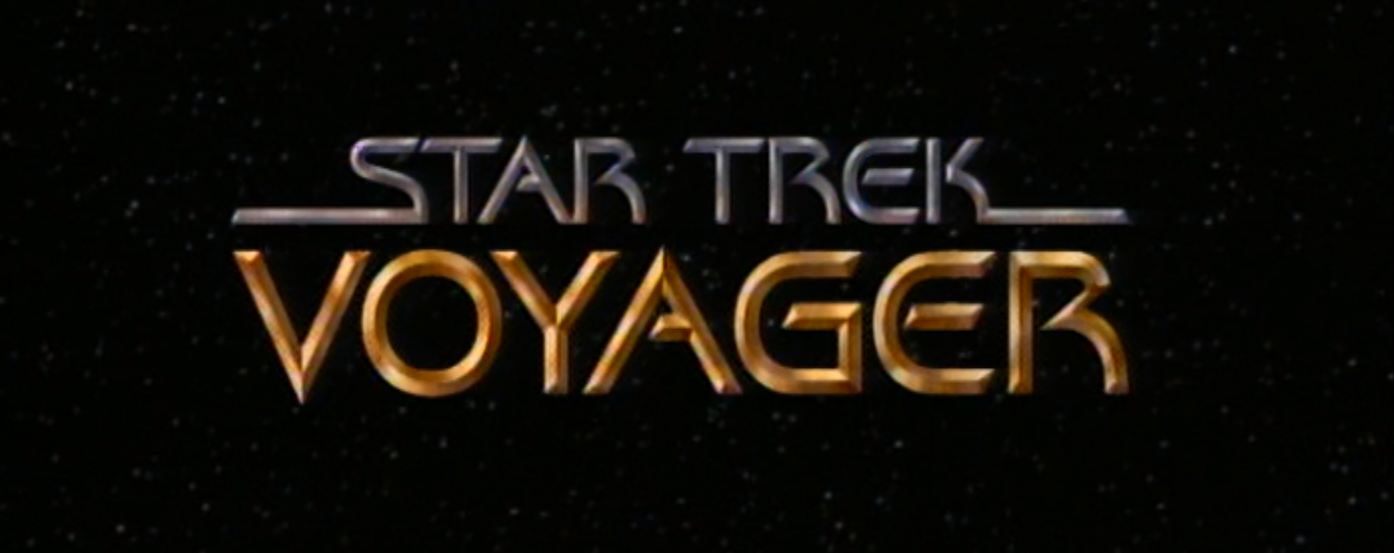
Welcome back to ‘Final Frontier Friday‘ for our second ever episode of ‘Star Trek: Voyager’! Call it an early New Year’s resolution (at least as far as the column is concerned) but it’s high time I did more than just bounce back and forth between the original series and ‘The Next Generation’. To that end, we’ll be closing out 2017 with a look at the fourth season episode ‘Mortal Coil’.
Written by Bryan Fuller (yes, that Bryan Fuller), the episode began life in a vastly different form. Originally pitched as an episode involving an immortal, regenerative alien who – purely for fun – would repeatedly trick the Doctor into killing him, the show’s writing staff soon developed the premise into something that Fuller compared to ‘Pet Sematary’. In that version of the story, it was Samantha Wildman who was killed on an away mission. She would then be resurrected using Borg technology, but (as in the Stephen King novel) she would come back “wrong”. Described by Fuller as being “more connected with death than life,” the resurrected Wildman would set about trying to kill her young daughter Naomi, albeit for the specific purpose of bringing her back to life so that the two would be able to share the experience.
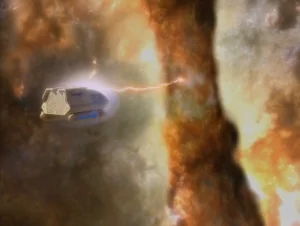
Gee, I wonder why that version didn’t fly?
From there, the episode was reconceptualized with Chakotay as the character who would return from death. After concerns were raised involving traditional Native American views on the afterlife and the often vaguely defined nature of Chakotay’s spirituality, the central character was once again changed. It was at this point that ‘Mortal Coil’ took on its final form as a Neelix episode, though Chakotay would continue to feature prominently in the finished episode.
The episode begins as Neelix roams the mess hall with a pot of coffee. As he does so, Chakotay approaches him about joining an away mission. The ship has come across a protomatter nebula, and (having apparently never seen ‘Star Trek III’) they’ve decided to collect a sample for use as a potential power source. Why Neelix? He had some experience with the stuff in his days as a trader. Chakotay leaves, and Neelix encourages Seven of Nine to join the ship’s upcoming celebration of Prixin, a Talaxian holiday before he’s summoned to read Samantha Wildman’s daughter Naomi a bedtime story. To that end, he tells Naomi about the Great Forest, a Talaxian afterlife myth. The away mission goes smoothly, right up to the moment they try to beam the protomatter sample into a containment module. The transporter beam ignites the nebula, causing an energy discharge to strike the shuttle and kill Neelix.
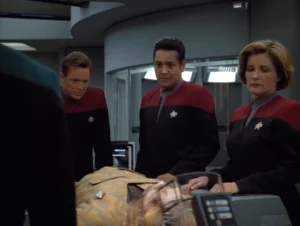
Upon exiting the nebula, the away team is beamed directly to sickbay, where the Doctor assures Paris and Chakotay that there was nothing they could have done. As Janeway begins planning a memorial, Seven enters and details a procedure by which Borg technology can be used to (for want of a better word) repair the damage Neelix has sustained, effectively bringing him back to life. It is a success.
As Neelix collects himself, the Doctor wryly congratulates him on setting a new record, having been resuscitated after nearly nineteen hours. As Janeway walks him back to his quarters, Neelix seems to be in his usual good spirits, making suggestions for the next attempt to retrieve a protomatter sample (if there is a next time, a prospect that Janeway is less than sanguine about) and discussing his plans for the first night of Prixin. But once the door closes behind him, he looks around his quarters, obviously shaken by the experience. Though we don’t yet have the full story, it’s clear there’s more to it than just a brush with death. Later, Neelix joins Chakotay on the holodeck to review a simulation of the accident (the Commander is trying to pinpoint anything that might’ve gone wrong). As the simulation progresses, Neelix seems distracted. When the energy discharge hits “him,” he freezes the program and kneels beside his holographic corpse. When Chakotay joins him, Neelix explains the source of his angst: He died “and there was nothing there.” According to Talaxian belief, the dead are greeted by their late friends and family in the Great Forest. It’s a notion that gave Neelix a great deal of comfort, particularly since losing much of his family in a war. This crisis of faith, it seems, has left the typically jovial man with a bitter, nihilistic edge.
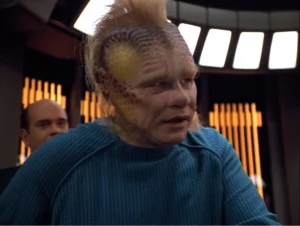
As the Prixin celebration begins, Paris toasts a visibly preoccupied Neelix. When Samantha mentions how much Naomi has missed him, he is visibly relieved and seizes on the excuse to duck out of the party. He puts Naomi to bed with his usual aplomb, but when the young girl asks to hear about the Great Forest he deflects before reluctantly recounting a story that he longer believes in.
As Seven runs a bioscan on Neelix at the Doctor’s behest, he confesses that doesn’t “feel like Neelix” anymore, quickly becoming irate shouting at Seven before collapsing his body begins to reject the Borg nanoprobes that are keeping him alive. As he recovers in sickbay, he asks Chakotay to help him embark on a vision quest. To that end, the two later meet in Chakotay’s quarters. As the vision quest begins, Neelix finds himself at a Prixin celebration, but the imagery soon takes a turn for the disturbing when he spots his sister (or “the dead girl” a vision of Janeway cheerfully describes her) and follows her to the guiding tree in the Great Forest. His sister decays, the forest darkens, and before long his friends appear, calmly telling him to “let go,” that “it’s all a lie.” He awakes with a scream.

Later, Neelix apologizes to Seven for his outburst, though there’s an odd finality to his words as if he’s saying farewell. Chakotay then confronts him in the mess hall. Part of the deal was that he would help Neelix interpret his visions, though Neelix has been avoiding this part. He has also, we realize, been less than forthright about the nature of his vision. He says, for example, that he saw his sister, but leaves out the disturbing imagery. After this conversation, Neelix leaves the mess hall and we see him recording a suicide note before trying to beam into the nebula. The crew is able to override the transport from the bridge and Chakotay soon arrives in the transporter room. As Neelix tries to work around the override, Chakotay makes the connection to the vision quest, asking once again what he saw. Finally, Neelix comes clean, explaining exactly what he saw. The tipping point comes when Samantha Wildman arrives in the transporter room with no idea what she’s just walked into. Apparently, Naomi found monsters in the replicator, and as Chakotay observes, there’s only one crew member who’s qualified to handle that. With that, Neelix steps off the transporter pad and accompanies a visibly concerned Samantha to her quarters.
So that is a damn good episode. It takes a character who (especially as the series progressed) was far too often reduced to comic relief and gives him a rock solid dramatic outing. And to that point, Ethan Phillips owns this episode. It’s perhaps his finest hour on ‘Voyager’, and it’s wonderful to see the subtle acting choices Phillips makes as he shifts from Normal Neelix to Shellshocked Neelix, to a Neelix who is desperately trying to put on a brave face and seem normal, and finally to Suicidal Neelix. And all of that is in service of a story that deals with a crisis of faith in the face of perhaps the most universal questions there are.
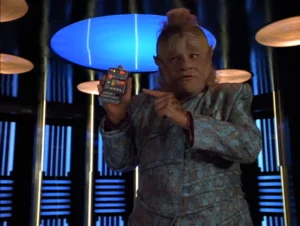
If the episode has one problem, it’s that the ending feels a bit abrupt. Neelix steps off the ledge (or transporter pad, as it were), tucks Naomi in, and his demeanor combines with a pleasant piece of incidental music to assure the audience that everything is going to be okay. Obviously, this sort of thing doesn’t wrap up that neatly in real life, and to an extent this is just a consequence of how dramatic television works. But it’s the sort of thing that could do with a follow up, if only in a passing reference to Neelix seeking counseling or some such. To the best of my recollection, though, that follow up never comes.
But I have to say, as strong an episode as ‘Mortal Coil’ is, it’s always struck me as one that would have worked better had it not been a ‘Voyager’ episode. Specifically, I feel it would have worked better had it been done as an episode of ‘Deep Space Nine’. Not only did that show lend itself much more to ongoing character studies than ‘Voyager’ did, it also had themes of faith baked into it. Go pull up Netflix and watch ‘Mortal Coil’. Now that you’ve seen it, try to imagine how much more impactful it might have been as a ‘Deep Space Nine’ episode, if Kira had been the character who returned from the grave. An exploration of faith and the importance of religion to the Bajoran people is a fundamental part of what ‘Deep Space Nine’ was, and few characters embodied that quite as well as Kira Nerys. While Neelix is a character who hadn’t been shown to have much of a spiritual side until he died, that same spirituality informed virtually every aspect of Kira’s life and it was established virtually from the word “go”. To me, at least, that makes Kira the far more interesting character through whom to explore a crisis of faith (especially since, as Chakotay notes, such a crisis can just as easily leave a person’ faith even stronger than it was before).
And on a lighter note, ‘Mortal Coil’ is also the episode in which we learn that the Borg don’t consider the Kazon to be worth the effort it would take to assimilate them. More sympathetic, I could not be.
What do you think of ‘Mortal Coil’? Is it right at home on ‘Voyager or should this have been sent across the lot to ‘Deep Space Nine’? As always, let me know in the comments and check back for our next installment in 2018. Until then, just make sure you get the new year off to a good start!
